Burma's Beginnings
Sunday 12 December – Thursday
16 December
On a hot and dusty plain
southeast of Mandalay, more than 2,000 temples stretch to the heavens.
The place is called Bagan, and it is one of
the wonders of Asia. While each monument is
different and unique in itself, it is the whole temple-studded expanse that
creates the aura of past grandeur and mystery for which Bagan is renowned.
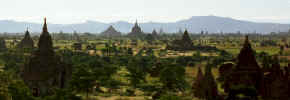
The kingdom of Bagan was founded
in 849 AD, but it was not until one King Anawrahta ascended the throne and unified
the country that the building frenzy began.
He brought back from his conquests artisans, monks and artists
and, legend has it, over 30 elephant-loads of Buddhist scriptures.
Thus the style of the early buildings was influenced by these architects;
they were built square and squat with arches and a complex pattern of brickwork.
By the time the most famous Pagoda of Anawrahta’s reign was in
construction, a distinctly Burmese style had evolved and the stark lines of
earlier monuments dissolved into softer, more fluid contours.
Building continued for over two
centuries and an enormous number of magnificent buildings were erected.
But, in 1287, the city was sacked by the Mongol warlord Kublai Khan and was never
rebuilt. In 1975, an earthquake
caused major damage, but funds provided by the United Nations have allowed
extensive restoration to take place, and now almost everything of importance has
been either restored or reconstructed.
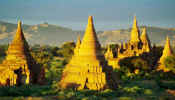 The buildings range
dramatically in size, shape and design. The
predominant building material was red brick and some display the use of white stucco.
Stupas
soar above the main structures of the monuments, casting dramatic
shadows across the landscape. Many of them have terraces running around their perimeters at
several different levels, and it is from the highest of these
The buildings range
dramatically in size, shape and design. The
predominant building material was red brick and some display the use of white stucco.
Stupas
soar above the main structures of the monuments, casting dramatic
shadows across the landscape. Many of them have terraces running around their perimeters at
several different levels, and it is from the highest of these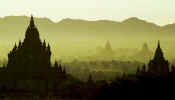 that
we delighted in the sunrises and sunsets during which the many-templed landscape
seemed to glow, pale and watery in the early morning, red and hazy at
dusk.
that
we delighted in the sunrises and sunsets during which the many-templed landscape
seemed to glow, pale and watery in the early morning, red and hazy at
dusk.
Impressive, yes. Unique,
certainly. But worth a 4.00am wakeup call?
Eric, always desperate to
capture the ultimate artistic shot, didn’t seem to mind a bit as the
phone rang and the front desk informed us our driver was ready each morning,
long before dawn.
He was positively disappointed not to be the first person to climb up his
chosen pagoda and, as if his enthusiasm needed proving, we have roll upon roll
of film featuring sunrises and sunsets of Bagan … not all of them witnessed by
Pippa!
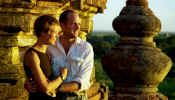 It was on the terrace of one
such monument, during one such spectacular photo opportunity, that we bumped into
Iain once again and joined him for dinner that night (and others that followed)
for more great British humor and tales of foreign lands.
Now well into photography mode, Eric (whose first reaction to finding out
what professional photographers - like Iain - will
It was on the terrace of one
such monument, during one such spectacular photo opportunity, that we bumped into
Iain once again and joined him for dinner that night (and others that followed)
for more great British humor and tales of foreign lands.
Now well into photography mode, Eric (whose first reaction to finding out
what professional photographers - like Iain - will 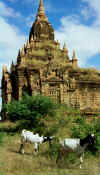 pay for their cameras was one
of horror) was now convinced that we simply had to purchase a Leica M6. Having been
asked to take a snap or two for Iain, his only explanation for such a change of
heart (it was now Pippa who was horrified at the thought of spending so much
money) was that it was all to do with the “click”.
There is no question that whatever he remembers of Bagan in 50 years time
(with respect to the splendor of the monuments we visited), he will not have
forgotten that click.
pay for their cameras was one
of horror) was now convinced that we simply had to purchase a Leica M6. Having been
asked to take a snap or two for Iain, his only explanation for such a change of
heart (it was now Pippa who was horrified at the thought of spending so much
money) was that it was all to do with the “click”.
There is no question that whatever he remembers of Bagan in 50 years time
(with respect to the splendor of the monuments we visited), he will not have
forgotten that click.
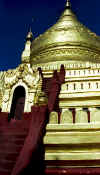 But we digress.
Of all the monuments in Bagan, the most impressive is considered to be
the Shwezigon Pagoda. It is said to contain important relics of Buddha including
two bones and a copy of a tooth but aside from that, it was the first major
construction built in the Burmese style following their conversion to Theravada
Buddhism. It is a traditionally
shaped golden pagoda and this graceful bell shape was to become a prototype for
almost all later stupas
But we digress.
Of all the monuments in Bagan, the most impressive is considered to be
the Shwezigon Pagoda. It is said to contain important relics of Buddha including
two bones and a copy of a tooth but aside from that, it was the first major
construction built in the Burmese style following their conversion to Theravada
Buddhism. It is a traditionally
shaped golden pagoda and this graceful bell shape was to become a prototype for
almost all later stupas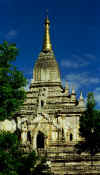 across Burma. Figures
of the 37 pre-Buddhist deities, called nats, are on display, and worshippers descend on this
pagoda more than any other to wish for good fortune at the revolving wheel inside.
across Burma. Figures
of the 37 pre-Buddhist deities, called nats, are on display, and worshippers descend on this
pagoda more than any other to wish for good fortune at the revolving wheel inside.
In almost three days, we
probably managed to cover most of the more significant monuments, but only a
tiny fraction of the 2,217. You could fill weeks, literally, navigating your way through
the maze of constructions dotted across this vast plain but in the time we had,
we were pleased with the range of pagodas we had been able to visit and were
ready to move on. But before we
left, we took time out from temple spotting to visit some of the local
lacquerware artisans and peruse this highly regarded Burmese tradition.
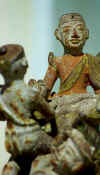
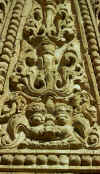
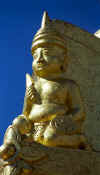
Bagan is the centre of Burma’s
lacquerware industry and has been producing high quality pieces since the time
of King Anawrahta. Articles range
from betel boxes to drinking cups, plates and bowls. The raw black lacquer is sap tapped from the thitsi tree (a
variety of sumac), while the frame of each article is woven of bamboo or horsehair.
Coats of lacquer are applied to the frame, dried, colored with a single hue and
engraved, then the process is repeated several times to bring 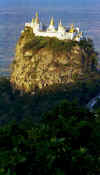 through all
desired colors on the finished piece. It is a highly labor-intensive
business, and good pieces take a year to make.
It is fascinating to watch the artisans at work and needless to
say, we now have several pieces of lacquerware, both antique and modern, adorning
our shelves to remind us of this unique Burmese tradition.
through all
desired colors on the finished piece. It is a highly labor-intensive
business, and good pieces take a year to make.
It is fascinating to watch the artisans at work and needless to
say, we now have several pieces of lacquerware, both antique and modern, adorning
our shelves to remind us of this unique Burmese tradition.
From Bagan, we travelled by car
to Mount Popa, a few hours drive to the southeast.
This is considered to be the home of the nats that continue to be worshipped
long after the country’s adoption of Buddhism.
On the summit of the mountain sits a pagoda, accessed by a partially
covered staircase that goes all the way to the top.
At the base is a monastery but by far the most impressive view of the
mountain was from a neighbouring hilltop, where we camped out for two days in an
eco-lodge watching yet more sunsets and sunrises from our balcony and running
our way through yet more film in search of that perfect shot.